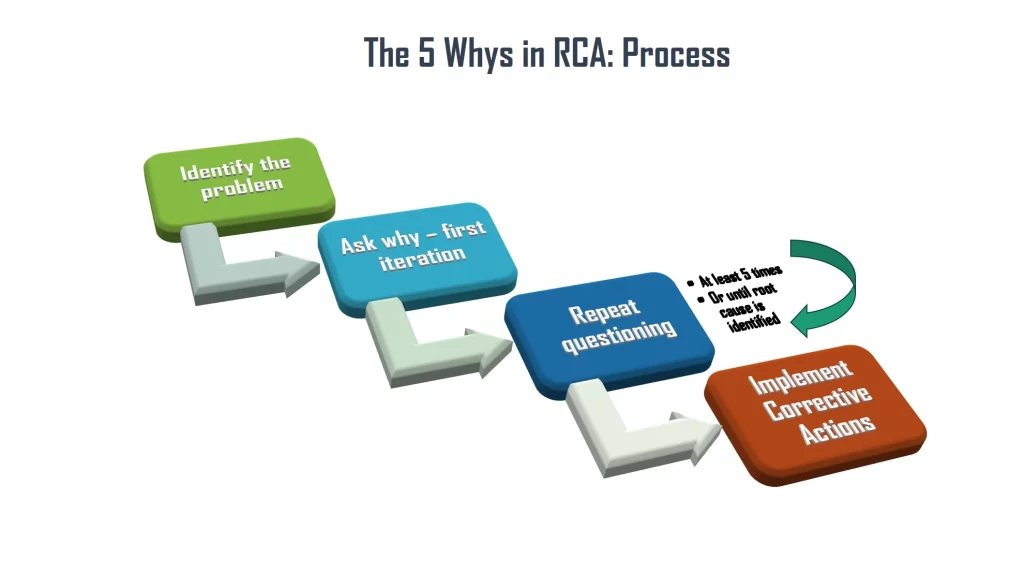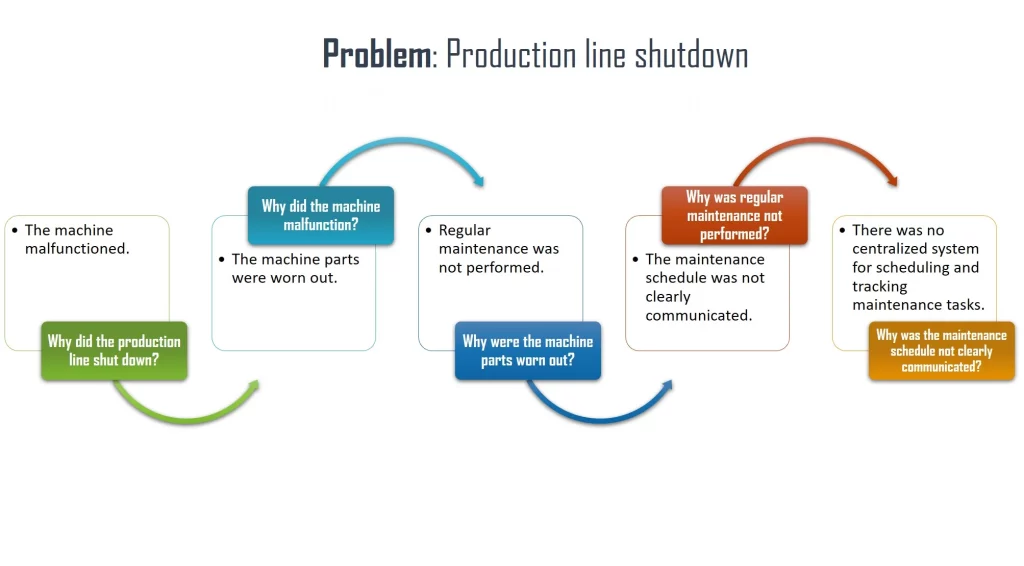
The “5 Whys” is a simple but powerful technique used in Root Cause Analysis (RCA) to identify the underlying causes of a problem. It involves repeatedly asking “Why” to drill down into the root cause of an issue. The name “5 Whys” is somewhat arbitrary; the idea is to continue asking “Why” until a satisfactory and actionable root cause is identified. The number of iterations may be more or less than five.
5 Whys: Process
- Identify the Problem: Start by clearly defining the problem or the undesired outcome.
- Ask “Why” for the First Iteration:
- Repeat the Questioning:
- Reach the Root Cause:
- Implement Corrective Actions: Once the root cause is identified, implement corrective actions to address it and prevent the recurrence of the problem.
The 5 Whys technique helps teams go beyond surface-level symptoms and understand the deeper issues contributing to a problem. It encourages a deeper level of thinking and problem-solving, fostering a proactive approach to addressing the root causes of issues.
Examples
Example in Production:
Here is an example to illustrate the 5 Whys in Root Cause Analysis:

A. Problem: Production line shutdown
| Why | Question | Answer |
|---|---|---|
| 1 | Why did the production line shut down? | The machine malfunctioned. |
| 2 | Why did the machine malfunction? | The machine parts were worn out. |
| 3 | Why were the machine parts worn out? | Regular maintenance was not performed. |
| 4 | Why was regular maintenance not performed? | The maintenance schedule was not clearly communicated. |
| 5 | Why was the maintenance schedule not clearly communicated? | There was no centralized system for scheduling and tracking maintenance tasks. |
B. Root Cause Identified: The lack of a centralized system for scheduling and tracking maintenance tasks led to a breakdown in communication about the maintenance schedule, resulting in worn-out machine parts and ultimately causing the production line shutdown.
C. Corrective Actions:
- Implement a centralized maintenance scheduling system.
- Ensure clear communication and training on the new system.
- Regularly monitor and update the maintenance schedule.
By using the 5 Whys, the team moved beyond the immediate symptom of a production line shutdown to uncover the deeper issue related to communication and maintenance scheduling. Addressing the root cause helps prevent similar incidents in the future.
Example in Human Resources
Here is another example in HR to illustrate the 5 Whys in Root Cause Analysis:
A. Problem: High employee turnover in a department
| Why | Question | Answer |
|---|---|---|
| 1 | Why is there high employee turnover in the department? | Employees are leaving for better job opportunities. |
| 2 | Why are employees leaving for better job opportunities? | Salaries in the department are not competitive. |
| 3 | Why are salaries in the department not competitive? | The company’s salary structure has not been updated for several years. |
| 4 | Why has the company’s salary structure not been updated? | There is a lack of awareness about market salary trends. |
| 5 | Why is there a lack of awareness about market salary trends? | The HR department does not regularly conduct salary benchmarking. |
B. Root Cause Identified: The lack of regular salary benchmarking by the HR department has resulted in an outdated salary structure, leading to non-competitiveness and high employee turnover.
C. Corrective Actions:
- Conduct regular salary benchmarking to stay informed about market trends.
- Update the salary structure to be more competitive.
- Communicate the changes in the salary structure to employees.
- Monitor employee satisfaction and retention rates.
By using the 5 Whys, the team uncovered the deeper issue related to salary competitiveness and identified a need for regular salary benchmarking to address the root cause and improve employee retention.
Example in Retail:
Let’s explore a 5 Whys example in a retail context where there’s an issue with delayed order fulfillment:
A. Problem: Delayed order fulfillment for online customers.
| Why | Question | Answer |
|---|---|---|
| 1 | Why are online orders experiencing delays? | Orders are not being processed in a timely manner. |
| 2 | Why are orders not being processed in a timely manner? | The inventory management system is showing discrepancies. |
| 3 | Why is the inventory management system showing discrepancies? | There are inconsistencies between the physical inventory and the system records. |
| 4 | Why are there inconsistencies between physical inventory and system records? | Receiving and updating of inventory are not synchronized. |
| 5 | Why is the receiving and updating of inventory not synchronized? | There is a lack of real-time integration between the receiving system and inventory database. |
B. Root Cause Identified: The delayed order fulfillment is primarily caused by a lack of real-time integration between the receiving system and the inventory database, leading to discrepancies and processing delays.
C. Corrective Actions:
- Implement a real-time integration solution between the receiving system and inventory database.
- Conduct regular audits to ensure physical inventory aligns with system records.
- Provide training to staff on accurate and timely inventory updates.
- Monitor order processing times and customer feedback to gauge improvements.
The corrective actions target the identified root cause to enhance the synchronization of inventory data, ultimately improving the efficiency of order fulfillment in the retail setting.
In conclusion, the key to a successful 5 Whys Root Cause Analysis (RCA) is to ask iterative “Why” questions to uncover the deeper causes of a problem systematically. It involves thorough exploration, collaboration, and persistence to identify the root cause accurately. The process should focus on actionable and preventive solutions, and the team should be open to adjusting the number of iterations based on the complexity of the issue.
